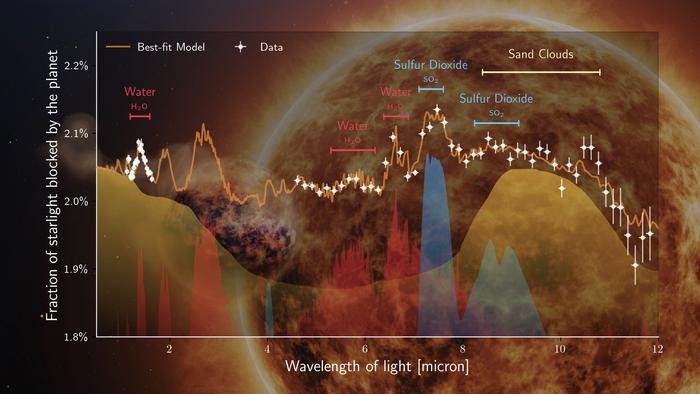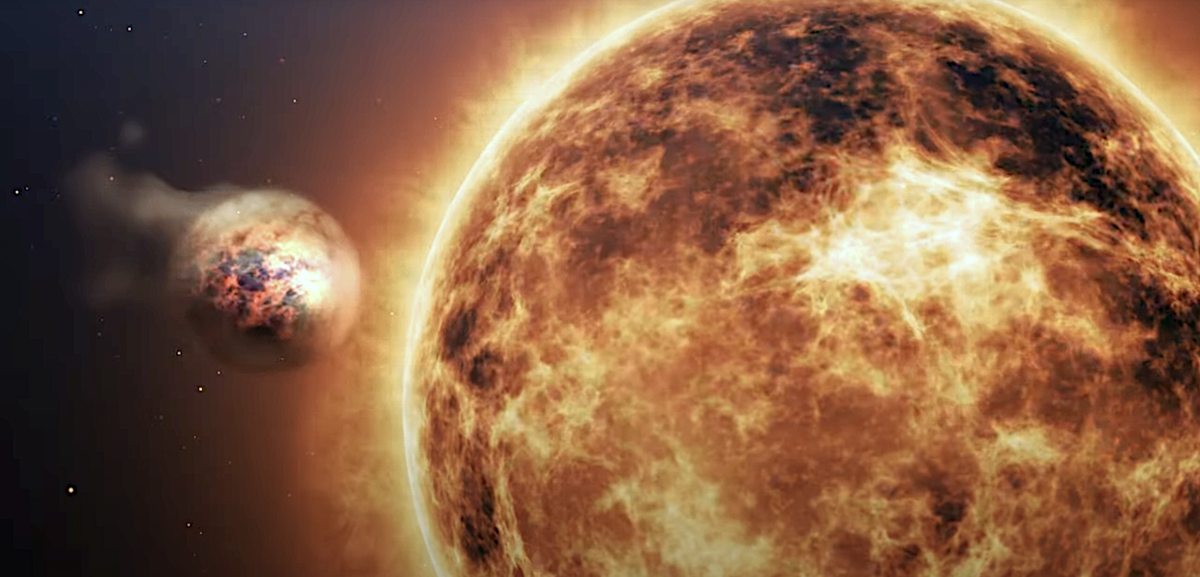Astronomers report that the James Webb Space Telescope (JWST) recently detected water vapor, sand clouds, and sulfur dioxide in the atmosphere of the exoplanet WASP-107b, according to newly published findings.
Led by a team of European astronomers from Belgium’s KU Leuven University, the researchers pointed the JWST’s Mid-Infrared Instrument (MIRI) at the exoplanet, located roughly 211 light-years from Earth. Their discovery, now published in Nature, has revealed the presence of water vapor, sulfur dioxide, and silicate sand clouds while notably lacking methane, a common greenhouse gas.
WASP-107b is a low-density exoplanet orbiting WASP-107. Discovered in 2017, the exoplanet immediately challenged our understanding of planetary development. The super-Neptune planet, meaning it’s larger than Neptune, has a surprisingly low density. This has implications for our understanding of gas giant formation and structure.
Moreover, it orbits very close to its star, with a year lasting only about 5.7 Earth days. Due to its proximity to its star, astronomers still need clarification on how the planet can retain an atmosphere, which generally would burn up due to its proximity to its star.
The recent discovery has only complicated astronomers’ understanding of this unique gas giant.


(Image: Michiel Min / European MIRI EXO GTO team / ESA / NASA; Klaas Verpoest (LUCA School of Arts, Belgium.)
Due to its atmospheric conditions, WASP-107b is distinguished by its ‘fluffy’ nature. Astronomers were able to peer deep into its atmosphere. This fluffiness, combined with the precision of the JWST infrared system, has enabled a new understanding of the planet’s atmospheric composition.
The absence of methane in WASP-107b’s atmosphere is intriguing, hinting at a potentially warm interior and shedding light on the planet’s internal heat dynamics. Detecting sulfur dioxide, typically associated with the smell of burnt matches, was unexpected, as previous models had not predicted its presence.
According to the report, due to the “fluffy” atmosphere and the general cooler temperatures of the planet’s host star, photons from the star can penetrate deeper into the planet’s gaseous atmosphere, allowing for complex chemical reactions to occur. Moreover, the discovery of water vapor in the atmosphere was also surprising since it seems connected to giant clouds made of sand.
Elements like water and sulfur do not appear often in cloudless atmospheres, so the fact that they were detected indicates that WASP-107b has high-altitude clouds. The JWST was able to peer into these clouds and indicated that they were a silicate-type material, similar to sand on Earth. According to traditional models of exoplanet formation, sand clouds like this usually form much closer to the planet’s surface, where the temperature is much warmer. However, since WASP-107b’s atmospheric temperature sits at around 500 degrees Celsius, the clouds seemingly “fluff” up into the upper atmosphere due to its close proximity to a star.
The endurance of these high-altitude sand clouds is similar to Earth’s water cycle. Silicate vapors from evaporated sand droplets in hotter, deeper layers rise and then recondense into clouds at cooler, higher altitudes. This vaporization and condensation process keeps the sand clouds persisting high in the atmosphere.
“The fact that we see these sand clouds high up in the atmosphere must mean that the sand rain droplets evaporate in deeper, very hot layers and the resulting silicate vapour is efficiently moved back up, where they recondense to form silicate clouds once more,” explained lead author Dr. Michiel Min. “This is very similar to the water vapour and cloud cycle on our own Earth but with droplets made of sand.”
Professor Leen Decin of KU Leuven emphasized that JWST’s discovery is reshaping our comprehension of planetary formation and evolution, offering new perspectives on the Solar System itself. Moreover, the study demonstrates how JWST can characterize exoplanets without counterparts in our own Solar System.
WASP-107b, with all its fluffiness, points astronomers to a whole new host of possible planetary incarnations that have yet to be discovered. While this exoplanet is undoubtedly inhospitable to life, at least as we know it, it allows us to imagine strange new worlds that do not fit the mold of planetary evolution.
MJ Banias is a journalist and podcaster who covers security and technology. He is the host of The Debrief Weekly Report and Cloak & Dagger | An OSINT Podcast. You can email MJ at mj@thedebrief.org or follow him on Twitter @mjbanias.
Correction: In the original version of the article, there was an error in the copy stating that “Neptune is distinguished by its ‘fluffy’ nature.” It has been corrected to state that “WASP-107b is distinguished by its ‘fluffy’ nature.” Thank you to Debrief reader H. Paden for contacting the author and noting it.

